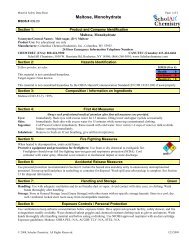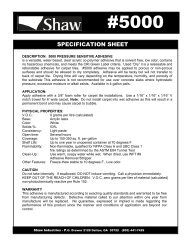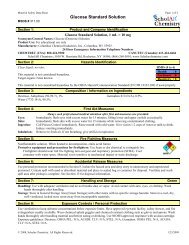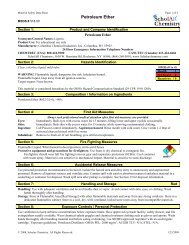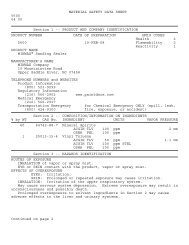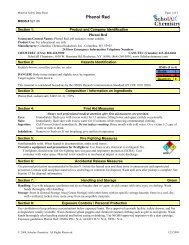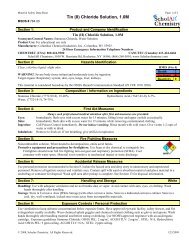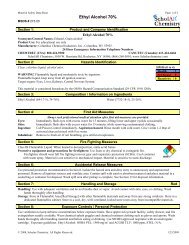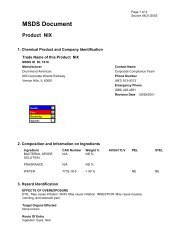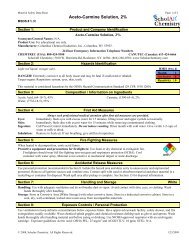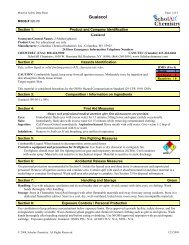Kendall SHP Grease 2.pdf
Kendall SHP Grease 2.pdf
Kendall SHP Grease 2.pdf
Create successful ePaper yourself
Turn your PDF publications into a flip-book with our unique Google optimized e-Paper software.
<strong>Kendall</strong> <strong>SHP</strong> <strong>Grease</strong> 2<br />
(MSDS #7894020000) Page 4 of 6<br />
Do not wear contaminated clothing or shoes. Use good personal hygiene practices.<br />
High pressure injection of hydrocarbon fuels, hydraulic oils or greases under the skin may have serious<br />
consequences even though no symptoms or injury may be apparent. This can happen accidentally when using<br />
high pressure equipment such as high pressure grease guns, fuel injection apparatus or from pinhole leaks in<br />
tubing of high pressure hydraulic oil equipment.<br />
"Empty" containers retain residue and may be dangerous. Do not pressurize, cut, weld, braze, solder, drill,<br />
grind, or expose such containers to heat, flame, sparks, or other sources of ignition. They may explode and<br />
cause injury or death. "Empty" drums should be completely drained, properly bunged, and promptly shipped to<br />
the supplier or a drum reconditioner. All containers should be disposed of in an environmentally safe<br />
manner and in accordance with governmental regulations.<br />
Before working on or in tanks which contain or have contained this material, refer to OSHA regulations, ANSI<br />
Z49.1 and other references pertaining to cleaning, repairing, welding, or other contemplated operations.<br />
Storage: Keep container(s) tightly closed. Use and store this material in cool, dry, well-ventilated<br />
areas away from heat and all sources of ignition. Store only in approved containers. Keep away from any<br />
incompatible material (see Section 10). Protect container(s) against physical damage.<br />
8. EXPOSURE CONTROLS/PERSONAL PROTECTION<br />
Engineering controls: If current ventilation practices are not adequate to maintain airborne concentrations below<br />
the established exposure limits (see Section 2), additional ventilation or exhaust systems may be required.<br />
Personal Protective Equipment (PPE):<br />
Respiratory: Inhalation is not an expected route of exposure. However, a NIOSH certified<br />
air purifying respirator with a Type 95 (R or P) particulate filter may be used under<br />
conditions where airborne concentrations are expected to exceed exposure limits (see<br />
Section 2).<br />
Protection provided by air purifying respirators is limited (see manufacturer's respirator<br />
selection guide). Use a positive pressure air supplied respirator if there is potential<br />
for uncontrolled release, exposure levels are not known, or any other circumstances where<br />
air purifying respirators may not provide adequate protection.<br />
A respiratory protection program that meets OSHA's 29 CFR 1910.134 and ANSI Z88.2<br />
requirements must be followed whenever workplace conditions warrant a respirator's use.<br />
Skin:<br />
The use of gloves impervious to the specific material handled is advised to prevent skin<br />
contact and possible irritation (see manufacturers literature for information on<br />
permeability).<br />
Eye/Face: Approved eye protection to safeguard against potential eye contact, irritation, or<br />
injury is recommended. Depending on conditions of use, a face shield may be necessary.<br />
Other Protective Equipment: A source of clean water should be available in the work<br />
area for flushing eyes and skin. Impervious clothing should be worn as needed.<br />
9. PHYSICAL AND CHEMICAL PROPERTIES<br />
Note: Unless otherwise stated, values are determined at 20°C (68°F) and 760 mm Hg (1 atm).<br />
Burn Rate (solids only): No Data<br />
Appearance: Red<br />
Physical State: Semi-solid<br />
Odor: Mild bland petroleum<br />
Vapor Pressure (mm Hg):



